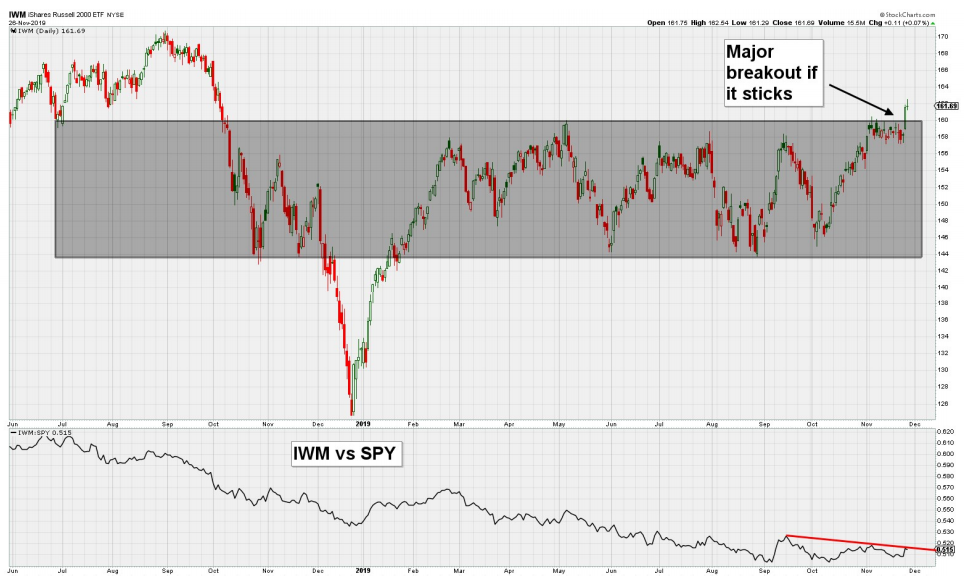Welcome to the party, little fella.
Small-cap stocks have been a missing piece of the puzzle as the stock market roared back in 2019 from a fourth-quarter drop last year that saw the S&P 500 SPX, +0.39% come within a whisker of a 20% pullback, the widely used definition of a bear market. This week, the small-cap Russell 2000 RUT, +0.53%, which did fall into a bear market during last year’s rout, posted a potential breakout, hitting its first 52-week high in 15 months on Monday and extending gains so far this week.
Need to Know: December selloff warning from strategist who predicted last year’s rout
“The inability for the Russell 2000 to break out was one of the concerning signs present over the past couple of weeks (notice small-caps hadn’t been doing much for most of November), but now that has resolved itself and should be bullish for the broad market,” said Andrew Adams, analyst at Saut Strategy, in a Wednesday note.
Read: Beware stock-market ‘FOMO’ as Wall Street churns out records, says long-term bull
“The next steps will be sustaining this rally to potentially break out to new all-time highs over last year’s August peak and hopefully break out against the S&P 500 as well,” he said, noting the performance of the iShares Russell 2000 ETF IWM, +0.57% relative to the SPDR S&P 500 ETF Trust SPY, +0.40% in the lower panel of the chart below.
 Saut Strategy
Saut Strategy Small-cap valuations imply further upside potential for small-caps on both an absolute basis and relative to the S&P 500, said Sam Stovall, chief investment strategist at CFRA, in a Wednesday note.
The S&P SmallCap 600 is trading at an 8% discount to its average and relative price-to-earnings ratios since 1995, he said. S&P SmallCap 600 earnings per share are projected to climb nearly 25% in 2020, according to S&P Capital IQ consensus estimates, versus the 3.3% decline seen for 2019, Stovall noted.
The large-cap benchmark S&P 500 is up more than 25% year to date, while the blue-chip Dow Jones Industrial Average DJIA, +0.15% is up more than 20% and the tech-heavy Nasdaq COMP, +0.61% stands more than 30% higher over the same stretch. All three major indexes have posted a record close 10 times each in November.
See: Stock-market optimism gauge hits an extreme — and that explains a lot, analyst says
While the Russell 2000 is up more than 20% in the year to date, it’s still shy of returning to record territory. Over the last 12 months, the index is up 9.2%, far behind the 17.3% rise by the S&P 500 over the same stretch, as well as the 13.7% gain for the Dow and a nearly 23% rise for the Nasdaq. The Russell through Tuesday remained 6.7% below its record close of 1,740.75 hit on Aug. 31, 2018, according to Dow Jones Market Data.
The Russell 2000 is up around 2.5% this week and 4.3% in November, versus a week-to-date gain of 1.2% and a 3.6% monthly rise so far by the S&P 500.
“Seeing small-caps at 52-week highs is further confirmation to the overall health of this bull market,” said Ryan Detrick, senior market strategist at LPL Financial, in a blog post. “We’ve already seen large-caps and various countries around the world break out, and now we have participation from a once-lagging group. Participation is the key to any lasting bull market, and this is another great sign as we head into 2020.”
Historically, a return to a 52-week high by the Russell 2000 after more than a year has been a positive sign for forward returns, Detrick said, noting that in the past instances dating back to October 1982 the index has risen 10 out of 11 times over the next 12 months with an average rise of 17% and a median gain of 16.4%.
Stocks were putting in modest gains Wednesday, hitting a new round of records despite the traditional holiday doldrums. U.S. markets are closed Thursday for Thanksgiving Day and will see an abbreviated trading session on Friday.
See: When do markets close for Thanksgiving?










Add Comment